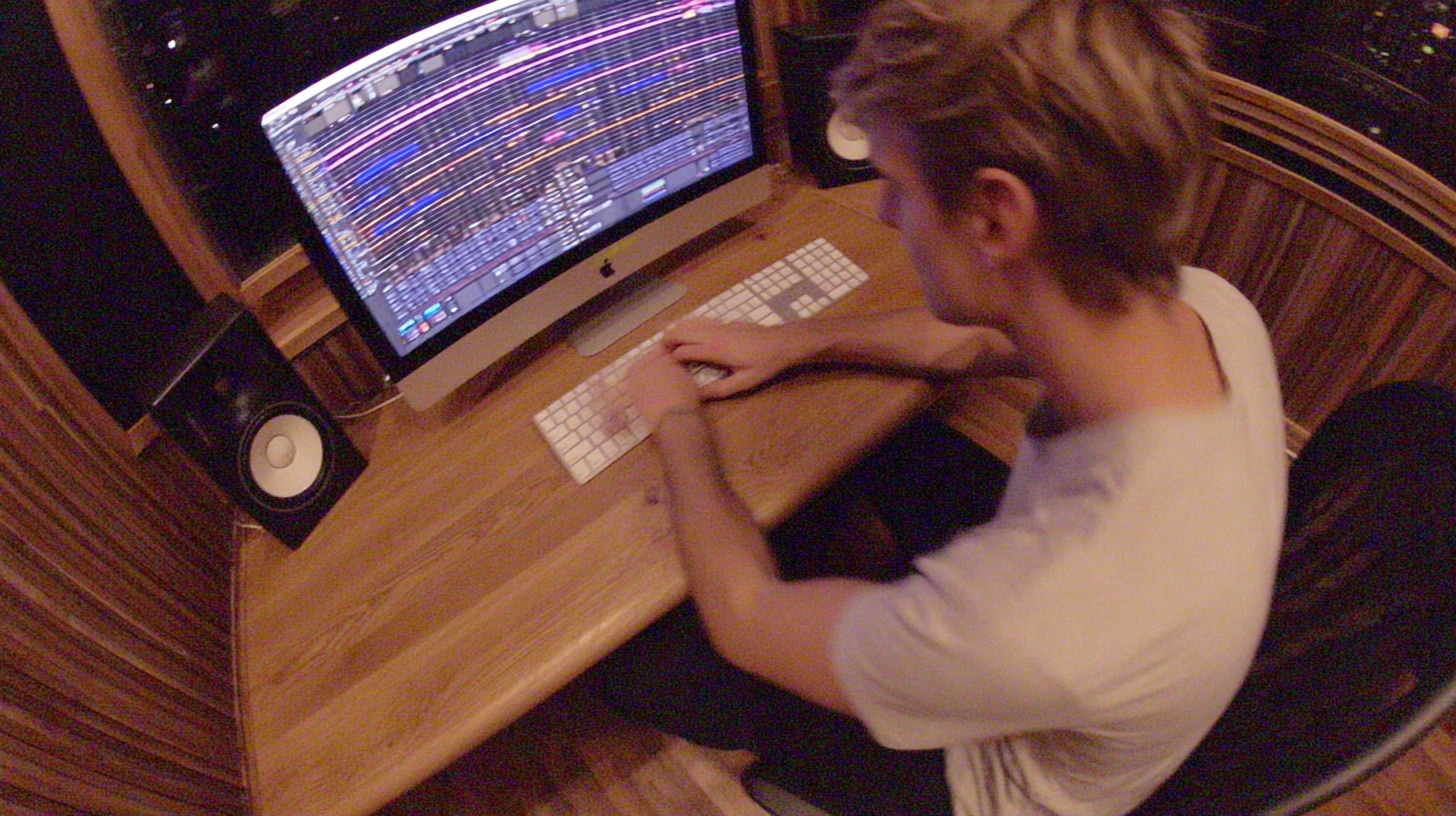
# Mixing Asking Alexandria’s “Into The Fire” for Modern Metal
Nail The Mix Staff
Asking Alexandria’s self-titled record was a huge moment, blending massive electronic soundscapes with their signature heavy rock sound. A perfect example is the track “Into The Fire,” a masterclass in modern production where dense synths and an ocean of vocals have to coexist with a powerful rock rhythm section. It’s the kind of mix that can feel impossible to balance.
This isn’t your typical metal mix where distorted guitars steamroll everything. To make a track like this punch, you have to be strategic. It’s an exercise in balance, restraint, and knowing which elements need to shine. We got to unbox the raw multi-tracks from the original session with producer Taylor Larson. Let’s break down the key techniques used to build this modern metal anthem.
The Vocal is King: Taming a Wall of Sound
The first thing you notice in the “Into The Fire” session is the sheer number of vocal tracks. This song absolutely lives and dies by Danny Worsnop’s performance, and the production is built to support it.
Working with Pre-Printed Vocal Effects
One of the coolest parts of this session is that many of the vocal effects—delays, tails, and special FX—were given to us already printed on their own tracks. Why? Because these effects are so specific and integral to the song’s vibe that they’re considered part of the production, not just an afterthought in the mix.
Your job as the mixer isn’t to create these effects from scratch, but to balance them. These pre-made effects sound incredible on their own, but the real challenge is to tuck them into the mix so they add depth and character without overwhelming the lead vocal or the rest of the instruments.
Juggling Layers: From Screams to Falsetto
Beyond the effects, you’re dealing with an insane amount of vocal layers. You’ve got the main lead, tons of doubles, intricate harmonies, powerful screams, and even a super cool falsetto bounce track. The goal is to make all these layers sound like one massive, cohesive performance. This requires careful gain staging, subtle compression to even things out, and precise automation to ensure the right part is in the spotlight at the right time.
Building Huge Drums from a Minimalist Kit
Looking at the drum tracks, you might be surprised. It’s a pretty minimalist setup: kick in/out, two snare tops and a bottom, three toms, a hi-hat, overheads, and a single small room mic. There are no pre-processed samples included, and the raw tracks sound like they were recorded in a tight, controlled space.
The Essential Role of Drum Samples
To get that final, polished album sound, you’re going to have to bring in samples. This session is the perfect playground to master your drum replacement skills. Because the drum performance isn’t overly busy and has a lot of space between hits, you can really focus on the details.
A pro tip here is to pay close attention to the tail of your snare samples. The raw snare is tight and dry, so blending in a sample with a long, lush reverb tail is key to creating that huge, arena-rock sound that Taylor Larson achieved on the final record.
Using a Small Room Sound to Your Advantage
Don’t be discouraged by the small room sound on the raw tracks. In fact, it’s a huge advantage. A dry, tight source recording gives you a blank slate. You don’t have to fight any undesirable room tone with EQ. Instead, you have total freedom to shape the space yourself with your own reverbs and samples, creating a custom sound that perfectly fits the mix.
The Dual-Bass Technique: Grit Meets Sub-Power
For the low end, the session gives us two bass tracks: a clean bass DI and a programmed Sub Bass track. This is a go-to technique in modern metal for achieving a low end that is both incredibly consistent and full of character.
The Crossover EQ Method
The trick to blending these two signals is to treat them like a crossover. You’re not just layering them; you’re making each one do a specific job.
Start with the bass DI. Use a high-pass filter to roll off the low end around 100-150Hz. This removes the deep sub frequencies and lets you focus the DI on providing the mid-range grind, string noise, and attack that helps the bass cut through the mix. Then, let the programmed Sub Bass track handle everything below that cutoff point. For more on creating space in your mix, check out these essential EQ strategies for modern metal.
The main challenge is balancing their levels so they sound like a single, powerful bass guitar, not two separate elements. A little bit of bus compression on both tracks can help glue them together into one cohesive instrument.
Guitars in a Supporting Role: Less is More
If you’re used to mixing guitar-centric metal, this track will force you to practice restraint. Aside from a printed lo-fi intro part, the guitars are all provided as clean, well-recorded DIs. On the original record, Taylor Larson used Toneforge Jason Richardson to craft the tones, but you can use your favorite amp sim.
The key thing to understand here is that the guitars are a supporting element. Their job is to provide rhythmic energy and a solid harmonic foundation, not to be the lead instrument. The riffs are intentionally simple to serve the song and, more importantly, to stay out of the way of the vocals and synths. If you push the guitar levels too high, you’ll instantly swallow the elements that make this song so unique.
Fitting It All Together: The Synth and Balance Puzzle
Last but not least, we have the synths. And there are a lot of them. The session is packed with synth orchestra layers, risers, impacts, and unique textures. Just listening to the vocal and synth arrangements on their own sounds massive enough to be a final track.
Now, you have to fit a full rock band in there too.
This is where your balancing game becomes critical. You can’t just make each element sound cool in solo and expect it to work. You need to think holistically. This means making deliberate and often surgical EQ moves to carve out a specific frequency pocket for each instrument. Be careful not to get carried away with how epic the synths sound on their own—every decision must serve the entire song.
Asking Alexandria on Nail The Mix
Taylor Larson mixes "Into The Fire"
Get the Session

100+ Insanely Detailed Mixing Tutorials
We leave absolutely nothing out, showing you every single step
Learn to Mix Like a Pro
Reading about these techniques is a great start, but there’s no substitute for hands-on practice. With Nail The Mix, you get to do more than just read about it—you get to do it yourself.
We give you the actual multi-tracks for “Into The Fire” so you can practice these exact techniques on the real session files. Plus, you get to watch a 6+ hour livestream where the original producer, Taylor Larson, mixes the song from scratch, explaining every single decision along the way.
If you’re ready to move beyond presets and truly understand how pro mixes are built, check out our comprehensive course, Unlock Your Sound.
Get the Asking Alexandria multi-tracks and our entire vault of pro-level mixing courses today. It’s time to put some hair on your chest and tackle a real-world mix.
Get a new set of multi-tracks every month from a world-class artist, a livestream with the producer who mixed it, 100+ tutorials, our exclusive plugins and more
Get Started for $1



